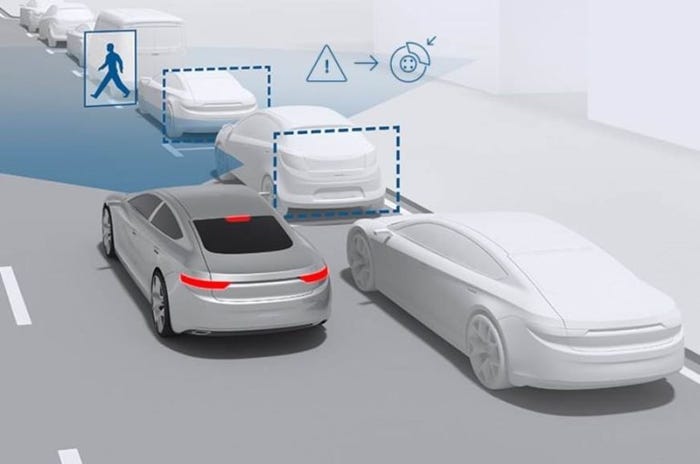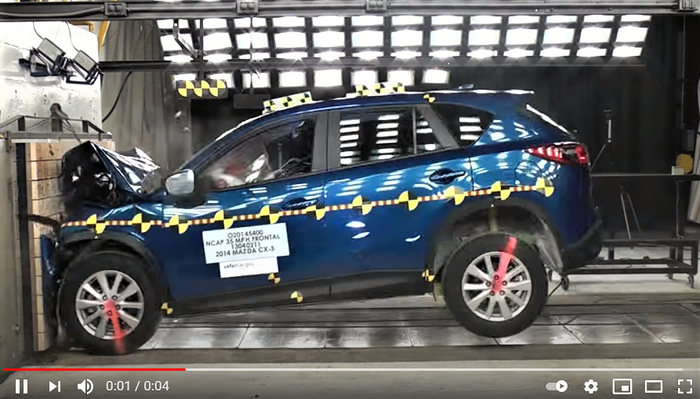Bosch Refining Automatic Emergency Braking TechnologyBosch Refining Automatic Emergency Braking Technology
With all the advances being made to automatic emergency braking technologies, Bosch says it’s high time for this kind of crash-avoidance technology to be included in the federal government’s New Car Assessment Program (NCAP).
September 22, 2021
.jpg?width=1280&auto=webp&quality=95&format=jpg&disable=upscale)
Prototype precursors to today’s automatic emergency braking (AEB) technology have been around in some form or another since the 1950s, but the complete, high-tech systems that can stop a car when it senses an object in the car’s path is just over a decade old. That’s enough time to understand how it works, but not enough time to be omnipresent.
In 2020, about 74% of passenger vehicles and light trucks sold in the U.S. came with AEB installed at the factory, according to data from Wards Intelligence. There is no mandate in the U.S. that new cars be equipped with AEB technology today.
Instead, automakers pledged in 2016 to voluntarily make AEB a standard feature on all new cars and trucks in the U.S. starting in 2022. Even once that happens, it will take years before every car on the road will have AEB installed, given that the overall penetration rate for AEB technology in all cars on U.S. roads today is less than 5%.
When we get to the 100% level of adoption, though, accident rates will go down. According to new accident research from Bosch, about a third of vehicle crashes with injuries or fatalities – 649,000 a year – would be avoided or mitigated if every car on the road had AEB.
This figure is based on data from the U.S. Department of Transportation’s Crash Report Sampling System from 2018, when there were a total of 1,889,000 crashes with injuries or fatalities in the U.S.
Bosch says 566,500 crashes could have been avoided with basic AEB technology, while another 64,000 would have been prevented with AEB with pedestrian detection and 18,500 would have not happened with AEB technology that detected cyclists.
“Think about that number – 649,000 crashes that could be avoided if AEB would be in all vehicles,” says Kay Stepper, senior vice president-automated driving, driver assistance for Bosch in North America. “Combine that with a continuously evolving technology – and we are far from being done developing this technology – what an impact that could make.”

Bosch-AEB (6)_0
AEB technology is more than a forward-facing radar (or rear-facing, when talking about AEB that works when you’re in reverse) and sensors to detect objects (pictured, above). It’s also the system that controls the brakes and the software that makes decisions.
Stepper says many improvements to AEB technology have been made just in the past two years, with rapidly evolving camera and sensing technologies that offer more resolution and more dynamic range information for the improved algorithms to work with. This lets new AEB systems detect people or bicyclists even when they are “hiding” behind a car or a sign.
“We have a unique approach with Bosch cameras that have what we call a multipass approach,” Stepper says. “We combine computer vision technologies and algorithms with artificial intelligence. It allows us to detect more securely and robustly partially obscured objects, including pedestrians.”
The second big improvement in AEB is radar technology that is continuously getting better, Stepper says. With new, higher-angular-resolution sensors and a wider vertical field of view, forward collision warnings (required for AEB) can be activated at higher speeds.
“These two (technologies), combined, really allow us to detect anything that could potentially venture into the path of travel of the vehicle earlier and react earlier,” Stepper says.
A third improvement to AEB technology is better brake system response time, which plays an important role in making AEB more effective because it’s not just about sensors and object identification. The car has to be able to physically stop itself, as well.
With all the advances being made to AEB technologies, Bosch says it’s high time for this kind of crash-avoidance technology to be included in the New Car Assessment Program (NCAP)(pictured, below).
“What we would like to see is this life-saving technology (AEB) to be implemented in the NCAP and we are not shy about this,” Stepper says. “The U.S. Department of Transportation and NHTSA are very well aware of our proposals for this topic.”
Stepper says today’s NCAP is focused on crashworthiness and fuel economy, but what’s missing are technologies that prevent a car from getting into a crash in the first place.
“Crash avoidance has been around now for more than ten years,” he says. “It’s high time to educate and let consumers know when they’re researching a new car, what are the crash avoidance technologies on the vehicle that they are interested in? And AEB would be one element of that.”

NCAP crash test screenshot_1
Read more about:
BoschAbout the Author
You May Also Like